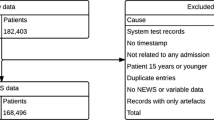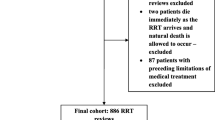Abstract
Objective
The national early warning score (NEWS) was developed to detect the early signs of patient deterioration with a view to instituting higher levels of care. There is a concern about the sensitivity of the NEWS score in patients with chronic hypoxaemic conditions.
Methods
This cross-sectional audit sought to determine the clinical relevance of a NEWS score of 7 or higher in medical patients by determining whether there was any change in clinical management. Patients with chronic hypoxaemic conditions had a modified early warning score applied retrospectively, the chronic respiratory early warning score (CREWS) to determine if it made a difference to the trigger threshold. The study also aimed to determine the discharge outcome of such patients.
Results
A NEWS score ≥7 did not result in a change in clinical management in 64.6 % of cases; 94.1 % of patients with no change in clinical management were subsequently discharged home. Oxygen supplementation and oxygen saturation were the primary determinants of elevated NEWS scores with 89.9 and 31.6 % of cases having high scores, respectively; 19.7 % of patients were receiving home oxygen therapy. Retrospective application of the CREWS scoring system in these patients would have reduced the number of reviews by 70.3 %.
Conclusions
In medical patients admitted to a Model 2 hospital with chronic respiratory illness, the ‘respiratory variables’ of the NEWS score are poor discriminators of patients who are clinically deteriorating. Better tools (such as the CREWS score) are required to distinguish acutely ill from chronically ill patients with respiratory disease in Model 2 hospitals.

Similar content being viewed by others
References
Health Service Executive. Training Manual for The National Early Warning Score and associated Education Programme. http://www.hse.ie/eng/about/Who/clinical/natclinprog/acutemedicineprogramme/earlywarningscore/compasstrainingmanual.pdf. Accessed 4 Sep 2012
Health Service Executive. About the NEWS and COMPASS Education Programme. http://www.hse.ie/eng/about/Who/clinical/natclinprog/acutemedicineprog/earlywarningscore/aboutnews.html. Accessed 4 Sep 2012
Health Service Executive. National Early Warning Score Observation Sheet. http://www.hse.ie/eng/about/Who/clinical/natclinprog/acutemedicineprog/earlywarningscore/observation.pdf. Accessed 4 Sep 2012
Royal College of Physicians (2012) National Early Warning Score (NEWS): Standardising the assessment of acute illness severity in the NHS. Report of a working party. RCP, London
Kane B, Decalmer S, Murphy P, Turkington P, O’Driscoll B (2012) S29 The Proposed National Early Warning System (NEWS) Could Be Hazardous For Patients Who Are at Risk of Hypercapnic Respiratory Failure. Thorax 67:A16–A17
O’Driscoll BR, Murphy P, Turkington PM (2012) Acute monitoring of patients with chronic respiratory disease during hospital admission. Clin Med 12:79–81
Eccles SR, Subbe C, Hancock D, Thomson N (2013) CREWS: improving specificity whilst maintaining sensitivity of the National Early Warning Score in patients with chronic hypoxaemia. Resuscitation. doi:10.1016/j.resuscitation.2013.08.277 [Epub ahead of print]
O’Driscoll BR, Howard LS, Davison AG, British Thoracic Society (2008) BTS guideline for emergency oxygen use in adult patients. Thorax 63((Suppl VI)):vi1–vi68. doi:10.1136/thx.2008.102947
Health Service Executive. St. John’s Hospital, Limerick. http://www.hse.ie/eng/services/Find_a_Service/hospitals/stjohns/St_John’s_Hospital,_Limerick.html. Acessed 4 Sep 2012
Franklin C, Mathew J (1994) Developing strategies to prevent in-hospital cardiac arrest: analysing responses of physicians and nurses in the hours before the event. Crit Care Med 22:244–247
Jacques T, Harrison GA, McLaws ML, Kilborn G (2006) Signs of critical conditions and emergency responses (SOCCER): a model for predicting adverse events in the inpatient setting. Resuscitation 69:175–183
Watkinson PJ, Barber VS, Price JD, Hann A, Tarassenko L, Young JD (2006) A randomised controlled trial of the effect of continuous electronic physiological monitoring on the adverse event rate in high risk medical and surgical patients. Anaesthesia 61:1031–1039
Schein RMH, Hazday N, Pena M, Ruben BH, Sprung CL (1990) Clinical antecedents to in-hospital cardiac arrest. Chest 98:1388–1392
Bleyer AJ, Vidya S, Russell GB, Jones CM, Sujata L, Daeihagh P, Hire D (2011) Longitudinal analysis of one million vital signs in patients in an academic medical center. Resuscitation 82(11):1387–1392
Kellett J, Kim A (2012) Validation of an abbreviated Vitalpac™ Early Warning Score (ViEWS) in 75,419 consecutive admissions to a Canadian Regional Hospital. Resuscitation 83(3):297–302
Opio MO, Nansubuga G, Kellett J (2013) Validation of the VitalPAC™ Early Warning Score (ViEWS) in acutely ill medical patients attending a resource-poor hospital in sub-Saharan Africa. Resuscitation 84(6):743–746
Department of Critical Care, Queen Alexandra Hospital, Portsmouth Hospitals NHS Trust. Introduction Handbook for ICM. http://www.wessexics.com/resources/Trainee-ICM-handbook-v6-Sept-2012.pdf. Acessed 26 May 2013
O’Driscoll R. BTS Hospital Oxygen Audits 2008–2011—Presentation at British Thoracic Society meeting, Winter 2012. http://www.brit-thoracic.org.uk/Portals/0/Audit%20Tools/Audits2012/SummaryReports2012/1035%20O%27Driscoll%20Windsor%20Fri.ppt. Accessed 10 Jun 2013
O’Driscoll BR, Howard LS, Davison AG, On behalf of the British Thoracic Society (2008) BTS guideline for emergency oxygen use in adult patients. Thorax 63:vi1–vi68
Cvach M (2012) Monitor alarm fatigue: an integrative review. Biomed Instrum Technol 46:268–277
Austin MA, Wills KE, Blizzard L, Walters EH, Wood-Baker R (2010) Effect of high flow oxygen on mortality in chronic obstructive pulmonary disease patients in prehospital setting: randomised controlled trial. BMJ 341:c5462
Conflict of interest
Dr. Lobo has nothing to disclose. Ms. Lynch has nothing to disclose. Dr. Casserly has nothing to disclose.
Author information
Authors and Affiliations
Corresponding author
Rights and permissions
About this article
Cite this article
Lobo, R., Lynch, K. & Casserly, L.F. Cross-sectional audit on the relevance of Elevated National Early Warning Score in medical patients at a Model 2 hospital in Ireland. Ir J Med Sci 184, 893–898 (2015). https://doi.org/10.1007/s11845-014-1216-y
Received:
Accepted:
Published:
Issue Date:
DOI: https://doi.org/10.1007/s11845-014-1216-y




